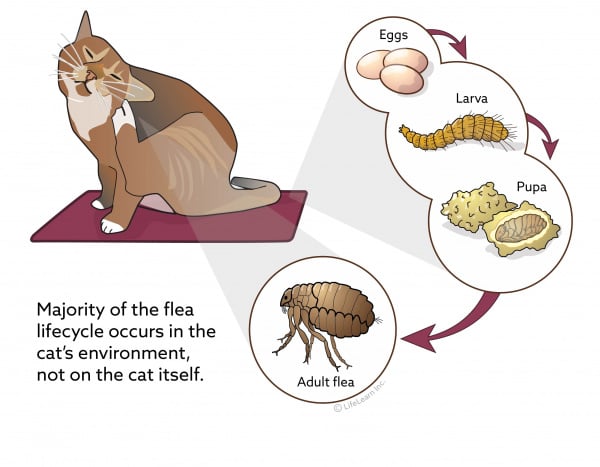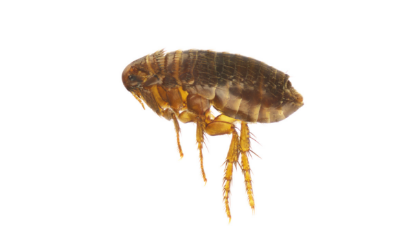How To Get Rid Of Fleas On Cats At Home

The most common flea found on cats and dogs is the cat flea (Ctenocephalides felis), although any species of fleas, including fleas from rabbits, squirrels, or other wildlife, can be found on cats.
"Under ideal conditions, the flea can complete its entire life cycle in as little as two weeks; in adverse conditions, the cycle can take as much as a year."
Adult fleas live, feed, and mate on our pets; the female flea lays eggs that fall off into the environment where they hatch into larvae. The larvae eat organic debris until they mature into pupae. The pupae may lie dormant for weeks to months, awaiting the ideal environmental conditions before hatching into adults. Newly hatched adult fleas jump onto a host animal to complete their life cycle. Two days after eating a blood meal from the host, the female flea begins to lay eggs. Under ideal conditions, the flea can complete its entire life cycle in as little as two weeks; in adverse conditions, the cycle can take as much as a year.
Where did my cat get fleas?
The most important source of cat fleas is newly emerged adult fleas from flea pupae in your house or yard.
Homes with carpets and central heating provide ideal conditions for the year-round development of fleas. The highest numbers of flea eggs, larvae, and pupae will be found in areas of the house where pets spend the most time, such as their beds and furniture. Even though fleas may be in your house, you probably will not see them.
The eggs are tiny white specks the size of dust particles, while the larvae, which are somewhat larger, with dark heads and lighter bodies, migrate deep down in carpets, furniture, or cracks in floors away from the light.
What effect do fleas have on my cat?
Many cats live with fleas but show minimal signs. However, the following problems can occur:
- Some cats develop an allergy to flea bites, especially if they are repeatedly bitten. Flea allergic cats groom or scratch excessively after being bitten by even a single flea, and often develop skin infections secondary to this self-trauma.
"Flea allergic cats groom or scratch excessively after being bitten by even a single flea."
- Adult fleas live on animals and feed on blood. A single adult flea consumes many times its weight in blood over its lifetime. If a kitten, or a debilitated or older cat, has a lot of fleas, the blood loss can be severe, resulting in anemia.
- The flea acts as the intermediate host for one species of tapeworm (Dipylidium caninum). This means that the tapeworm must complete part of its life cycle within a flea. Flea larvae become infected by eating tapeworm eggs, and if a cat swallows an infected flea while grooming, the tapeworm larva will develop into an adult tapeworm. Any cat with fleas is likely also to have a tapeworm infestation.
How can I get rid of fleas on my cat?
This can be a challenging task and requires a three-pronged approach. Fleas need to be eliminated from 1) your cat, 2) any other cats and dogs that you have, 3) your home and yard. Even this approach may not give 100% control, since you cannot control some sources of fleas such as other people's pets, wild animals, or property surrounding yours.
What products are available to treat my cat?
Although most topical insecticides kill adult fleas, many have limited effectiveness because they only work for a few hours after application. This is particularly true of flea shampoos and powders; they kill fleas present on your cat at the time of application but have little lasting effect; the following day the cat may again have fleas. Newer products with excellent residual activity are available from your veterinarian. Some products contain adulticide ingredients (kills adult fleas) with residual activity, while others contain insect growth regulators (IGR's) that prevent the larval stages from maturing. For best results in a flea infestation, use flea control products that contain an IGR.
ALWAYS READ THE LABEL CAREFULLY - apply the product as instructed and repeat at the intervals stated. Ensure that the product is labelled for use in cats, as some dog products may be poisonous to cats.
My cat hates being sprayed. What can I do? 
Many cats strongly dislike being sprayed. Consult your veterinarian, as there are several alternatives available. Many cat owners prefer to use topical flea products. These are applied monthly, and are recommended by veterinarians because they work well and are easy to apply.
Flea collars may seem convenient but most do not work well (the exception is flea collars that contain an IGR) and are not generally recommended. Flea collars, especially ones with a strong pesticide smell, may be harmful to some cats, or may cause a skin reaction or rash.
How can I treat my home environment?
A number of different products are available which will kill the adult and larval stages of fleas and stop the flea life cycle, such as:
- adulticide sprays for use in the house
- sprays containing insect growth regulators (IGR's) for use in the house
- insecticides applied by professional pest control companies
Sprays for use in the house should be used in places where the flea eggs, larvae, and pupae are likely to be. It is recommended that you treat the entire household first and then concentrate on the hot spots - your cat's favorite napping spots - such as soft furniture, beds, and carpets. Once they hatch from the egg, flea larvae move away from the light and burrow deep into carpets and into other nooks and crannies where they are difficult to reach. Be sure to move cushions, furniture, and beds to spray underneath them. Other places larvae are likely to live include baseboards and the cracks and crevices between floor seams or floorboards.
"You will need to throw away the vacuum bag to prevent eggs and larvae from developing inside the vacuum cleaner."
Flea eggs and pupae are extremely tough and resistant to the effects of insecticides. To remove these, as well as remove dead fleas, your pet's bedding should be washed in hot water or replaced.
Regular and thorough vacuuming of your carpets, floors, and soft furnishings can remove a large number of flea eggs, larvae, and pupae. You will need to throw away the vacuum bag to prevent eggs and larvae from developing inside the vacuum cleaner. Vacuuming prior to the application of a spray to the house is recommended because the vibrations will encourage newly developed fleas to emerge from pupae, which will then be killed by the insecticide.
How do I choose which products to use?
A flea control program needs to be individually tailored based on the lifestyle of your cat, other pets in your home, and your family situation. Your veterinarian is the best person to advise you about safe and effective flea control products.
Are insecticides safe for my cat and my family?
Insecticides for flea control should be safe both for pet dogs, cats, and humans, as long as the manufacturer's instructions are carefully followed. It is important to avoid combining insecticides with similar modes of action. Always seek your veterinarian's advice if you are unsure about this and always tell your veterinarian about any flea control products you may be using other than those that have been prescribed.
"Certain types of pets (e.g., birds, fish, amphibians, reptiles, and invertebrates) may be particularly susceptible to some products."
Certain types of pets (e.g., birds, fish, amphibians, reptiles, and invertebrates) may be particularly susceptible to some products. Do not use any flea control products in the room in which these pets are kept without first consulting your veterinarian for advice.
I have not seen any fleas on my cat. Why has my veterinarian advised flea control?
One of the most common causes of feline allergic skin disease is flea allergy dermatitis. To eliminate this possibility, your veterinarian may advise rigorous flea control even though no fleas can be found. If the cat's skin problem improves with flea control, it suggests that flea allergy is involved.
Fleas are easy to find if a cat is heavily infested. If fleas are present in smaller numbers, it can be harder to see them. Fleas move quickly! Try looking on the cat's stomach, around the tail base, and around the neck.
Sometimes adult fleas cannot be found but flea dirt can be seen. Flea dirt is fecal matter from the flea that contains partially digested blood, and it is a good indicator of the presence of fleas. Flea dirt is seen as small black specks or coiled structures; when placed on a damp, white tissue, the flea dirt dissolves, leaving a reddish brown stain. Flea dirt may be found in cat's bedding even when fleas cannot be found on the cat.
"Cats are very efficient at removing debris from their coat's using their tongues and may succeed in removing all evidence of flea infestation such as adult fleas and flea dirt."
In cats that develop an allergy to fleas, one of the symptoms is excessive grooming. Cats are very efficient at removing debris from their coat's using their tongues and may succeed in removing all evidence of flea infestation such as adult fleas and flea dirt.
I noticed my cat had fleas after her return from boarding. Did she get fleas there?
Not necessarily! Pre-adult fleas can survive for up to 140 days within their protective pupa. When you or your pets are absent from home for extended periods of time these adult fleas remain in the pupae because no host is available. As soon as you or your pet returns home, these fleas will emerge in large numbers and jump onto cats, dogs, and even people in the search for a blood meal. Vibrations (from walking) and/or increased carbon dioxide (from breathing) will trigger the emergence of fleas from their pupae.
Despite treating my cat for fleas she still has them. Is there a \"super flea\"?
There is no evidence of fleas developing resistance to insecticides, especially once-a-month topical flea preventives that contain a sterilizing agent or IGR in addition to the adulticide. Apparent failure of treatment almost always results from improper application of the preventive, inadequate treatment of the home, or exposure to other infested pets or environments. Consider treating storage sheds, cars, and any outdoor sleeping spots. Bear in mind that your cat may be going into other people's houses. Most of these problems can be overcome by using an effective product with residual activity on the cat in addition to treating your home.
How To Get Rid Of Fleas On Cats At Home
Source: https://vcahospitals.com/know-your-pet/flea-control-in-cats
Posted by: boardgreedur.blogspot.com

0 Response to "How To Get Rid Of Fleas On Cats At Home"
Post a Comment